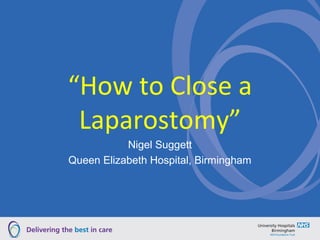
Laparostomy
- 1. “How to Close a Laparostomy” Nigel Suggett Queen Elizabeth Hospital, Birmingham
- 2. 3 Questions • How do you make a laparostomy • When do you close a laparostomy? • How do you close a laparostomy?
- 3. Aims of a laparostomy • Reduce intra-abdominal pressure • Facilitate further access • Manage exudate • Reduce oedema • Maintain abdominal domain • Protect bowel • Reduce adhesions from bowel to abdominal wall
- 4. Options • Skin Closure • Pack / Op-site • Bogota Bag • Topical Negative Pressure
- 5. Proprietary
- 6. D.I.Y Skin approximation skin muscle interface bowel
- 8. D.I.Y Skin suction Adhesive approximation dressing skin muscle interface bowel
- 9. TNP and open abdomen • Know what you are doing! • Protect and separate the bowel • Check 48-72h • Risk of fistulas?
- 10. When to Close?
- 11. When to close • Ideally <5 days • Before granulation/ adhesion • Try to avoid fascial retraction
- 13. How to Close? • 2o intention • Skin graft • Bridging • Gradual / Staged Closure • Direct Suture +/- Mesh • Component Separation +/- Mesh
- 14. Component Separation (Ramirez 1990) Bleichrodt et al.
- 15. Case • 51y M - LUQ Stabbing • Left renal vein, stomach and splenic hilum damaged • 24U Blood, 20U FFP , 4U plt • Pack + TNP • Re-look d1 - Colonic ischaemia – stapled off – TNP • Re-look d4 – Re-anastomosis – TNP – unable to close • Relook d9 – Unable to close
- 17. Component Separation 1-2cm
- 19. Component Separation 3-5cm upper abdo 7-10cm waist 1-3cm lower abdo
- 26. Mesh • Biologic (in this setting) • Intra-peritoneal • (Extra-peritoneal) • On-lay
- 30. Caution! • Returned to ward 5/7 later • Witnessed VF arrest ? cause • Aspirin, clopidogrel, therapeutic enoxaparin • Bleeding!!!!
- 31. So…… • Evacuation of haematoma and re-application of TNP – Tracheostomy – Fascia intact • Skin re-closed 4 days later • Discharged (after ICD)
- 32. Component Separation Pros Cons • A useful technique • Time consuming • Allows primary fascial • Potential morbidity closure • Gets you out of trouble • Can only be done once!
- 33. 3 Questions • How do you make a laparostomy – Depends on your knowledge and skills – Carefully and thoughtfully • When do you close a laparostomy? – As soon as it is safe to do so – Or not at all • How do you close a laparostomy? – Primary suture – Component Separation + Mesh – Or not at all
Notes de l'éditeur
- TNP – remains contraversial Fistula risk?